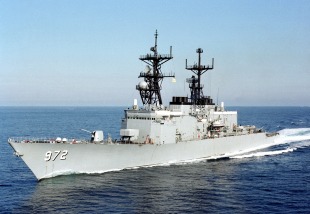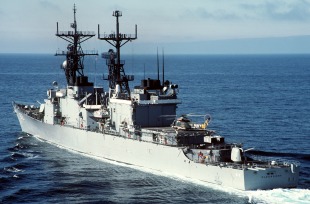Destroyer USS Oldendorf (DD-972)
Basic information
Ship measurements
Machine
- 4 * General Electric LM2500 gas turbines
- 2 * shafts, 80,000 shp (60 MW)
Personnel
Combat assets
- AN/SPS-40 air search radar
- AN/SPG-60 fire control radar
- AN/SPS-55 surface search radar
- AN/SPQ-9 gun fire control radar
- Mark 23 TAS automatic detection and tracking radar
- AN/SPS-65 Missile fire control radar
- AN/SQS-53 bow mounted Active sonar
- AN/SQR-19 TACTAS towed array Passive sonar
- Naval Tactical Data System
- AN/SLQ-32 Electronic Warfare System
- AN/SLQ-25 Nixie Torpedo Countermeasures
- Mark 36 SRBOC Decoy Launching System
- AN/SLQ-49 Inflatable Decoys
- 2 * 5 in (127 mm) 54 calibre Mark 45 dual purpose guns
- 2 * 20 mm Phalanx CIWS Mark 15 guns
- 1 * 8 cell ASROC launcher (removed)
- 1 * 8 cell NATO Sea Sparrow Mark 29 missile launcher
- 2 * quadruple Harpoon missile canisters
- 2 * Mark 32 triple 12.75 in (324 mm) torpedo tubes (Mk 46 torpedoes)
- 1 * 61 cell Mk 41 VLS launcher for Tomahawk missiles
- 1 * 21 round RIM-116 Rolling Airframe Missile
- 2 * Sikorsky SH-60 Seahawk LAMPS III helicopters
USS Oldendorf (DD-972), a Spruance-class destroyer, honored Admiral Jesse B. Oldendorf USN, one of the most esteemed surface warfare flag officers during World War II. Constructed by the Ingalls Shipbuilding Division of Litton Industries in Pascagoula, Mississippi, Oldendorf, the tenth destroyer of its class, commenced construction on December 27, 1974, was launched on October 21, 1975, and commissioned on March 4, 1978.
Initially stationed in San Diego, California, the ship's early period involved shipyard work in Long Beach, California, and multiple visits to Litton Shipbuilders in Pascagoula, Mississippi, necessitating three transits through the Panama Canal within the ship's first year of service.
During its initial Westpac deployment from May to November 1980, Oldendorf participated in joint anti-submarine exercises off Western Australia. The ship also made visits to Bunbury and Perth. Subsequent deployments included voyages to the Persian Gulf and engagements in various naval exercises and events in the Pacific region.
Transferred to Yokosuka, Japan, as part of the United States Seventh Fleet in 1984, Oldendorf engaged in exercises with major regional navies. Notable visits included being part of the first US warships to mainland China since 1949 and obtaining access to an Australian village as a gesture of goodwill to the US Navy.
Oldendorf played a vital role in the Gulf War, serving with distinction, supporting naval blockades, and escorting major warships, earning accolades like the Combat Action Ribbon. Throughout its service, the ship underwent overhauls, participated in joint exercises, and was involved in monitoring international events, such as responding to missile tests near Taiwan.
Scheduled as part of a reorganization in the Pacific Fleet's surface ships, Oldendorf was reassigned to Destroyer Squadron 23. It continued deployments, including missions in the Persian Gulf, exercises off Kuwait, and preparations for various joint operations.
In its final phase of service, Oldendorf was part of the Sea Swap initiative, involving the deployment of a single ship with crew swaps, and it undertook exercises to prepare naval forces for joint operations. Eventually, the ship was decommissioned in June 2003, stricken in April 2004, and sunk during a live-fire exercise off the coast of Washington in August 2005.
The emblem of the Oldendorf crest commemorates Admiral Oldendorf's pivotal role in the Battle of Surigao Strait. Elements like the shield, vertical blue bar, stars, and trident symbolize his achievements, heroism, and exceptional leadership during that historic battle. The ship's motto, «Ad Proelium Victoriamque Futuram» (To the Fight and Victory Ahead), epitomizes Admiral Oldendorf's charge to his forces before the Battle of Surigao Strait.
- Comments
 en
en ru
ru uk
uk




 United States Navy
United States Navy Ingalls Shipbuilding
Ingalls Shipbuilding